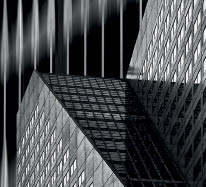Architecture

Architectural photography starts with finding suitable locations. Good sources for such information are suggestions from other photographers, Internet searches on cities and business districts (Google maps) and photo sites (forums). A good site is also: http://www.mimoa.eu, which lists interesting architecture in a lot of European cities. Be aware that some of these business areas or building surroundings could be private property. So don’t be too surprised if a security agent shows up asking what you are doing.
The most interesting lens for architectural photography is a (super)-wide angle. It gives dynamism to your compositions. A zoom lens offers the additional benefit of flexible focal lengths, allowing you to choose the optimum one for your composition. Fish-eye lenses could be interesting for already curved architectural structures.
Telephoto lenses can be interesting for capturing details or for isolating some rhythmic composition elements.
Try to avoid hard light. Morning or late afternoon light (and winter light) are ideal for capturing the structure and the plasticity of the buildings, creating more sense of depth. But due to “planned trips” or changed light conditions, it will not always be possible to get these better light conditions. The challenge then is to look for compositions that work in such light. Even rain can be interesting (offering the ...

